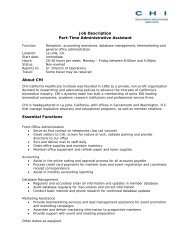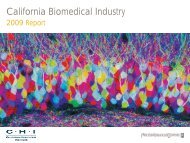California Biomedical Industry - California Healthcare Institute
California Biomedical Industry - California Healthcare Institute
California Biomedical Industry - California Healthcare Institute
You also want an ePaper? Increase the reach of your titles
YUMPU automatically turns print PDFs into web optimized ePapers that Google loves.
Sanford-Burnham Medical Research <strong>Institute</strong>Sanford-Burnham Medical Research<strong>Institute</strong> is dedicated to revealing thefundamental molecular causes of diseaseand devising the innovative therapies oftomorrow.With operations in <strong>California</strong> and Florida,Sanford-Burnham is one of the fastestgrowing private research institutes inthe country. The <strong>Institute</strong> ranks amongthe top four institutions nationally forNIH grant funding and among the top25 organizations worldwide for itsresearch impact. Sanford-Burnhamuses a unique, collaborative approachto medical research and has establishedmajor research programs in cancer,neurodegeneration, diabetes, infectiousand inflammatory and childhooddiseases. The <strong>Institute</strong> is known forits world-class capabilities in stemcell research and drug discoverytechnologies.CancerOne of the many challenges of creatingeffective cancer treatments is gettingenough medicine to the tumor to killit. Many treatments are administeredintravenously and blood flow insidetumors is often limited at best. Inaddition, tumors generate a naturaloutward pressure, which forcesanticancer drugs to “swim upstream.”As a result, treatments must be givenin large doses to get more medicine totumors.However, researchers have developed apeptide (a chain of amino acids) callediRGD that helps co-administered drugspenetrate deeply into tumor tissue. Thepeptide has been shown to improvetreatment efficacy against humanbreast, prostate and pancreatic cancersin mice, achieving the same therapeuticeffect as a normal dose with one-thirdas much of the drug. Erkki Ruoslahti,M.D., Ph.D., founding member of theUC Santa Barbara-Sanford-BurnhamCenter for Nanomedicine, KazukiN. Sugahara, M.D., Ph.D., TambetTeesalu, Ph.D., and fellow researchersat the Center for Nanomedicine andthe Cancer Center of Santa Barbaracollaborated on this research.Rare diseasesChildren with multiple hereditaryexostoses (MHE), a rare inheriteddisease, suffer from multiple growthson their bones that cause pain,disfigurement and stunted growth.At the moment, the only treatment issurgery to remove the growths, whichsometimes number in the hundreds.MHE research has long been hamperedby the lack of a good model that wouldanswer questions about the underlyingcause and allow scientists to test newtreatments. Recently, Yu Yamaguchi,M.D., Ph.D., and his collaboratorsunveiled a mouse model that does justthat.Earlier attempts at creating a mousemodel of MHE successfully replicatedthe human disease on a genetic level,but failed to reproduce the symptoms.In this new study, Dr. Yamaguchi andcolleagues, including Sanford-Burnhamscientists Dr. Kazu Matsumoto andDr. Fumitoshi Irie, took a differentapproach. Instead of deleting the genein the entire mouse, they targeted thegene in only bone cells. What’s more,they removed the gene in only a smallfraction of these cells.Surprisingly, this approach led to amouse with all the symptoms of MHE,including bony protrusions, shortstature and other skeletal deformities.Further investigations into the cellularmake up of the bone growths answeredsome long-standing questions abouthow they develop.Neurodegenerative diseasesNeurodegenerative diseases suchas Alzheimer’s, Parkinson’s andHuntington’s all have one thingin common: the untimely death ofnerve cells. New research at Sanford-Burnham shows that these diseases alsoshare the molecular mechanism thatleads to cellular death, a finding thatidentifies new targets for diagnosis andtreatment of these diseases. The study,which appeared in Molecular Cell, wasled by Dr. Stuart Lipton, director ofSanford-Burnham’s Del E. Web Centerfor Neuroscience, Aging and Stem CellResearch, and Dr. Tomohiro Nakamura,research assistant professor.Together with their collaborators, Drs.Lipton and Nakamura showed how agaseous molecule known as nitric oxide(NO) can throw a molecular switch toturn a cell from the path to survival tothe path to death. Scientists have long80 | <strong>California</strong> <strong>Biomedical</strong> <strong>Industry</strong> 2011 Report






